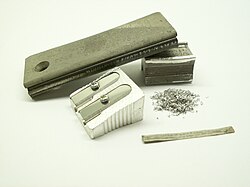Magnesium
Magnesium ( /mæɡˈniːziəm/ mag-NEE-zee-əm) is a chemical element. It has the symbol Mg, atomic number 12 and common oxidation state +2. It is an alkaline earth metal and the eighth most abundant element in the Earth's crust. It makes up 2% of the mass of the crust. It is the ninth most common element in the known universe.[6] This is because it is easily built up in supernova stars by addition of three helium nuclei to carbon (which in turn is made from three helium nuclei). Magnesium ion's high solubility in water helps ensure that it is the third most abundant element dissolved in seawater.[7]
 | |||||||||||||||||||||
| General properties | |||||||||||||||||||||
|---|---|---|---|---|---|---|---|---|---|---|---|---|---|---|---|---|---|---|---|---|---|
| Pronunciation | /mæɡˈniːziəm/ | ||||||||||||||||||||
| Appearance | shiny grey solid | ||||||||||||||||||||
| Standard atomic weight (Ar, standard) | [24.304, 24.307][1] | ||||||||||||||||||||
| Magnesium in the periodic table | |||||||||||||||||||||
| |||||||||||||||||||||
| Atomic number (Z) | 12 | ||||||||||||||||||||
| Group | group 2 (alkaline earth metals) | ||||||||||||||||||||
| Period | period 3 | ||||||||||||||||||||
| Block | s-block | ||||||||||||||||||||
| Element category | alkaline earth metal | ||||||||||||||||||||
| Electron configuration | [Ne] 3s2 | ||||||||||||||||||||
Electrons per shell | 2, 8, 2 | ||||||||||||||||||||
| Physical properties | |||||||||||||||||||||
| Phase at STP | Mg: Solid | ||||||||||||||||||||
| Melting point | 923 K (650 °C, 1202 °F) | ||||||||||||||||||||
| Boiling point | 1363 K (1091 °C, 1994 °F) | ||||||||||||||||||||
| Density (near r.t.) | 1.738 g/cm3 | ||||||||||||||||||||
| when liquid (at m.p.) | 1.584 g/cm3 | ||||||||||||||||||||
| Heat of fusion | 8.48 kJ/mol | ||||||||||||||||||||
| Heat of vaporization | 128 kJ/mol | ||||||||||||||||||||
| Molar heat capacity | 24.869 J/(mol·K) | ||||||||||||||||||||
Vapor pressure
| |||||||||||||||||||||
| Atomic properties | |||||||||||||||||||||
| Oxidation states | +1,[2] +2 (a strongly basic oxide) | ||||||||||||||||||||
| Electronegativity | Pauling scale: 1.31 | ||||||||||||||||||||
| Ionization energies |
| ||||||||||||||||||||
| Atomic radius | empirical: 160 pm | ||||||||||||||||||||
| Covalent radius | 141±7 pm | ||||||||||||||||||||
| Van der Waals radius | 173 pm | ||||||||||||||||||||
| Spectral lines of magnesium | |||||||||||||||||||||
| Other properties | |||||||||||||||||||||
| Natural occurrence | Mg: Primordial | ||||||||||||||||||||
| Crystal structure | hexagonal close-packed (hcp) | ||||||||||||||||||||
| Speed of sound thin rod | 4940 m/s (at r.t.) (annealed) | ||||||||||||||||||||
| Thermal expansion | 24.8 µm/(m·K) (at 25 °C) | ||||||||||||||||||||
| Thermal conductivity | 156 W/(m·K) | ||||||||||||||||||||
| Electrical resistivity | 43.9 nΩ·m (at 20 °C) | ||||||||||||||||||||
| Magnetic ordering | paramagnetic | ||||||||||||||||||||
| Magnetic susceptibility | +13.1·10−6 cm3/mol (298 K)[3] | ||||||||||||||||||||
| Young's modulus | 45 GPa | ||||||||||||||||||||
| Shear modulus | 17 GPa | ||||||||||||||||||||
| Bulk modulus | 35.4[4] GPa | ||||||||||||||||||||
| Poisson ratio | 0.290 | ||||||||||||||||||||
| Mohs hardness | 1–2.5 | ||||||||||||||||||||
| Brinell hardness | 44–260 MPa | ||||||||||||||||||||
| CAS Number | 7439-95-4 | ||||||||||||||||||||
| History | |||||||||||||||||||||
| Naming | after Magnesia, Greece | ||||||||||||||||||||
| Discovery | Joseph Black (1755) | ||||||||||||||||||||
| First isolation | Humphry Davy (1808) | ||||||||||||||||||||
| Main isotopes of magnesium | |||||||||||||||||||||
| |||||||||||||||||||||
Magnesium is the 11th most abundant element by mass in the human body. Its ions are essential to all living cells. The ions play a major role in manipulating important biological polyphosphate compounds like ATP, DNA, and RNA. Hundreds of enzymes thus require magnesium ions to function. Magnesium is also the metallic ion at the center of chlorophyll. It is a common additive to fertilizers.[8] Magnesium ions are sour to the taste, and in low concentrations help to impart a natural tartness to fresh mineral waters.
The free element (metal) is not found naturally on Earth, as it is highly reactive (though once produced, it is coated in a thin layer of oxide (see passivation), which partly masks this reactivity). The free metal burns with a brilliant white light, making it a useful ingredient in flares. The metal is now mainly obtained by electrolysis of magnesium salts obtained from brine.
Uses
Commercially, the main use for the metal is as an alloying agent to make aluminium-magnesium alloys, sometimes called "magnalium" or "magnelium". Since magnesium is less dense than aluminium, these alloys are prized for their relative lightness and strength.
Magnesium is used in fireworks to make a brilliant bright light. Another use is to mix it with other metals to make it strong, lightweight alloys such as those used to make bicycle frames.
Magnesium compounds are used medicinally as common laxatives, antacids (i.e. milk of magnesia), and where stabilization of abnormal nerve excitation and blood vessel spasm is required (that is, to treat eclampsia).
Magnesium is used in electronic devices, including: mobile phones, laptop computers, cameras, and other electronic components. Magnesium's low weight, good mechanical and electrical properties are good for these uses.
Magnesium reacted with an alkyl halide gives a Gringard reagent, which is a very useful tool for preparing alcohols.
Magnesium is also used in incendiary bombs, which are bombs that blow up and spread fire everywhere.
Forms
Alloys

As of 2013, magnesium alloys was used less than one million tonnes per year. This was a lot less than aluminium alloys. In the same year, 50 million tonnes of aluminium alloys were used. Using magnesium alloys have limited. This is because magnesium alloys can corrode,[9] creep at high temperatures, and combust.[10]
Compounds
Magnesium can makes many different compound. They are important in industry and biology. Some common magnesium compounds are magnesium carbonate, magnesium chloride, magnesium citrate, magnesium hydroxide, magnesium oxide, magnesium sulfate, and magnesium sulfate heptahydrate (Epsom salts).[11][12]
Isotopes
Magnesium has three stable isotopes. These isotopes are 24
Mg, 25
Mg and 26
Mg. All of these isotopes are very common in nature. About 79% of Mg is 24
Mg. The isotope 28
Mg is radioactive. In the 1950s to 1970s, many nuclear power plants made 28
Mg for experiments. This isotope has a fairly short half-life of 21 hours.
Safety
Magnesium burns at a very high temperature, and cannot be put out with water or an ordinary fire extinguisher. It must be extinguished with a class D fire extinguisher. Burning magnesium also produces ultraviolet radiation, which can harm the eyes if it is viewed directly.
Magnesium Media
Magnesium is brittle, and fractures along shear bands when its thickness is reduced by only 10% by cold rolling (top). However, after alloying Mg with 1% Al and 0.1% Ca, its thickness could be reduced by 54% using the same process (bottom).
An unusual application of magnesium as an illumination source while wakeskating in 1930
The Bugatti Type 57 Aérolithe featured a lightweight body made of Elektron, a trademarked magnesium alloy.
Magnesium firestarter (in left hand), used with a pocket knife and flint to create sparks that ignite the shavings
Audio async because of fractional time-lapse
Related pages
References
- ↑ Meija, J.; Coplen, T. B.; Berglund, M.; Brand, W.A.; De Bièvre, P.; Gröning, M.; Holden, N.E.; Irrgeher, J.; Loss, R.D.; Walczyk, T.; Prohaska, T. (2016). "Atomic weights of the elements 2013 (IUPAC Technical Report)". Pure and Applied Chemistry. 88 (3): 265–91. doi:10.1515/pac-2015-0305.
{{cite journal}}: Unknown parameter|displayauthors=ignored (|display-authors=suggested) (help) - ↑ Bernath, P. F.; Black, J. H.; Brault, J. W. (1985). "The spectrum of magnesium hydride" (PDF). Astrophysical Journal. 298: 375. Bibcode:1985ApJ...298..375B. doi:10.1086/163620.
{{cite journal}}: Unknown parameter|lastauthoramp=ignored (|name-list-style=suggested) (help) - ↑ Weast, Robert (1984). CRC, Handbook of Chemistry and Physics. Boca Raton, Florida: Chemical Rubber Company Publishing. pp. E110. ISBN 0-8493-0464-4.
- ↑ K. A. Gschneider, Solid State Phys. 16, 308 (1964)
- ↑ Bernath, P. F.; Black, J. H.; Brault, J. W. (1985). "The spectrum of magnesium hydride" (PDF). Astrophysical Journal. 298: 375. Bibcode:1985ApJ...298..375B. doi:10.1086/163620.
- ↑ Ash, Russell (2005). The Top 10 of Everything 2006: The Ultimate Book of Lists. Dk Pub. ISBN 0756613213. Archived from the original on 2010-02-10. Retrieved 2011-09-26..
- ↑ Anthoni, J Floor (2006). The chemical composition of seawater. http://www.seafriends.org.nz/oceano/seawater.htm#composition.
- ↑ "Magnesium in health".
- ↑ Makar, G. L.; Kruger, J. (1993). "Corrosion of magnesium". International Materials Reviews. 38 (3): 138–153. Bibcode:1993IMRv...38..138M. doi:10.1179/imr.1993.38.3.138.
- ↑ Dodson, Brian (29 August 2013). "Stainless magnesium breakthrough bodes well for manufacturing industries". Gizmag.com. Retrieved 29 August 2013.
- ↑ "8 Types of magnesium and their benefits". www.medicalnewstoday.com. 2021-03-23. Retrieved 2024-05-04.
- ↑ "Chemistry of Magnesium (Z=12)". Chemistry LibreTexts. 2013-10-02. Retrieved 2024-05-04.











